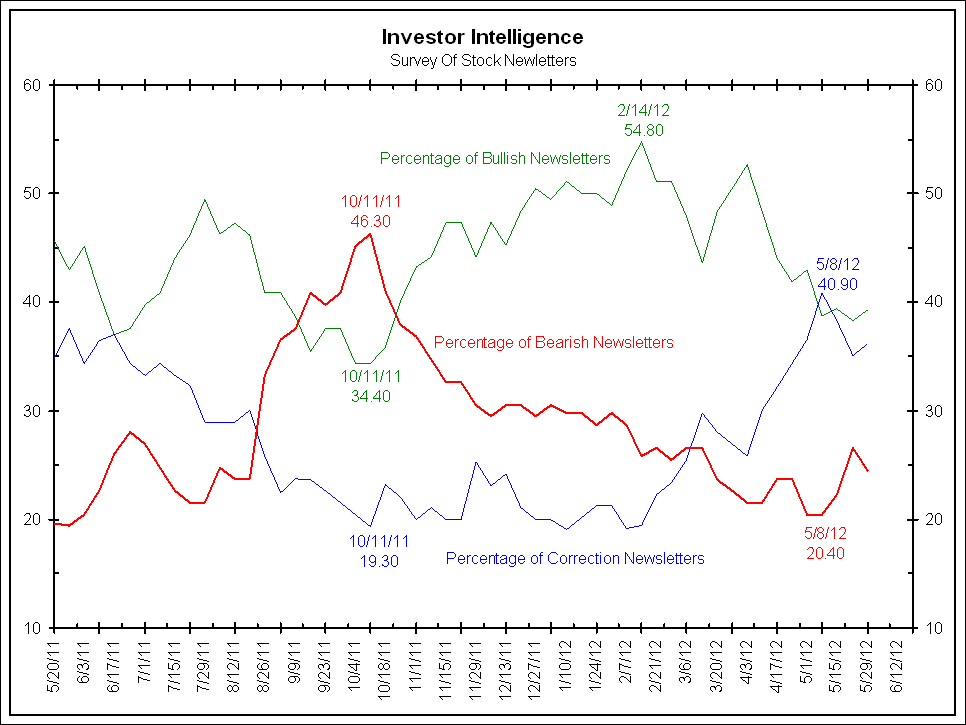Bloomberg Businessweek – Sentiment Signals S&P 500 Retreat May Not Be Over
Sentiment indicators have yet to show signs of extreme pessimism during the Standard & Poor’s 500 Index (SPX)’s retreat since April, suggesting there is still room for bears to push the market lower, according to UBS AG. While the proportion of newsletter writers who said they are bearish on equities rose to a two-month high of 26.6 percent last week, it’s still below the peak of 46.3 percent reached in October, when the S&P 500 hit its 2011 low, according to data from Investors Intelligence compiled by Bloomberg. The New York Stock Exchange Short-Term Trading Index, a volume-based market breadth indicator, reached a 2012 peak of 2.52 last month, failing to break 3.0, a level that Michael Riesner and Marc Mueller of UBS consider a sign of capitulation. “The missing panic sell-off and the low levels of bearishness are suggesting that we still have a high level of complacency in the market,” the Zurich-based analysts wrote in a note today. “With the current sentiment mix we can clearly say that the U.S. market is still far away from a contrarian bull call, which is one reason why it is likely to see more near term pain into June/July.”
Comment
Last week we highlighted that, despite numerous bearish themes sweeping through the markets, the percentage of bearish equity newsletter writers was actually low compared to historical norms. The chart below highlights a shorter-term version of the same Investors’ Intelligence data from last week’s post.
As the chart below shows, only 24.50% of the newsletter writers examined by Investors’ Intelligence were bearish as of May 29 (red line). This is near the lower end of its historical range. By definition, this group is looking for a decline of at least 20% over the next six months.
While one might expect an absence of bears to result in a large percentage of bullish newsletter writers, note that this is not the case. At 39.30%, the percentage of bulls is also low and on the decline (green line).
The third category measured by Investors’ Intelligence encompasses all the newsletter writers looking for a correction in an ongoing bull market (blue line). This group believes the market could decline by at least 10% before rebounding. As the chart below shows, the number of newsletter writers in this camp is near an all-time high at 36.20%.
Click to enlarge:
These three series combine to tell an interesting story. Normally one would expect the bearish camp to grow in popularity at the expense of the bullish camp and vice versa. Now, however, the percentage of bearish newsletter writers are near an extreme low while the percentage of bullish newsletter writers are also trending towards the lower end of their historical range. Meanwhile, the percentage of newsletter writers looking for a correction in an ongoing bull market has rarely been higher.
These charts are indicative of a confused market. Newsletter writers do not want to stick their necks out to be labeled a bull or a bear in this environment. The fear from a bearish standpoint is that the Federal Reserve or ECB could step in at any moment to put a floor on the market with further quantitative easing. The bulls, on the other hand, have to be worried with the direction the market has headed this month thus far in the absence of further quantitative easing.
The Federal Reserve, being the dominant driver of the markets over the past few years, has made the business of forecasting very difficult. Without knowing the future intentions of the FOMC with regards to quantitative easing, newsletter writers have no choice but to avoid being labeled a bull or a bear. Instead, they opt to predict the market will more or less move sideways.
Source: Bianco Research



What's been said:
Discussions found on the web: